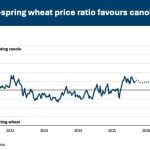BRANDON, Man. – There were few faces from the Red River Valley at a meeting of Manitoba’s farm lobby group last week.
But several farmers took time from helping neighbors sandbag and moving livestock away from threatening flood waters to make sure Keystone Agricultural Producers heard their concerns.
KAP agreed to lobby the federal and provincial governments to extend crop insurance seeding deadlines by five days for flood-stricken farmers.
A crop insurance official explained deadlines fall about a week after the time an average crop will achieve 80 percent of its potential yield.
Read Also

Farmers urged to be grain-safe this fall
Working around grain bins comes with risk, from farmers falling to drowning in grain: Experts have five tips to help avoid grain-related accidents this harvest.
Doug Wilcox said some of the deadlines were shortened by five days in 1993 after some farmers complained they were too generous, affecting coverage and premiums.
But farmers at the meeting questioned whether late springs automatically mean lower yields and more risk.
Lawrence Dyck, who farms just outside the Red River Valley in Roland, said in his experience, open falls, meaning no frost and warm weather, usually follow late springs.
Reg Dyck said many flooded farmers in the valley had to switch to Polish canola last year because they missed the crop insurance deadline for higher yielding Argentine varieties.
But Wilcox said the late spring, open fall theory has never been scientifically established.
In the Red River Valley, farmers who want crop insurance must plant crops like lentils and faba beans by May 20, while they can seed Polish canola until June 20.
Wilcox said with good drying conditions, most acres will likely be sown within the crop insurance deadlines.
“There’s still a fair bit of comfort even within our current deadlines that you can get out and seed a variety of crops.”
Alan Ransom, who farms at Boissevain, said valley farmers will race the clock to clean debris off fields, repair equipment, apply fertilizer and find seed while dealing with washed-out roads and the personal stress caused by a flood of this magnitude.
“We hope for the best, but I think we need to look at how we can accommodate what is a significant problem,” Ransom said.
Wilcox said changing the deadlines could affect risks and premiums for the program. Under law, crop insurance programs have to meet the approval of actuaries, those who assess risks and premiums. If they don’t, governments have to make up any losses to the program.














